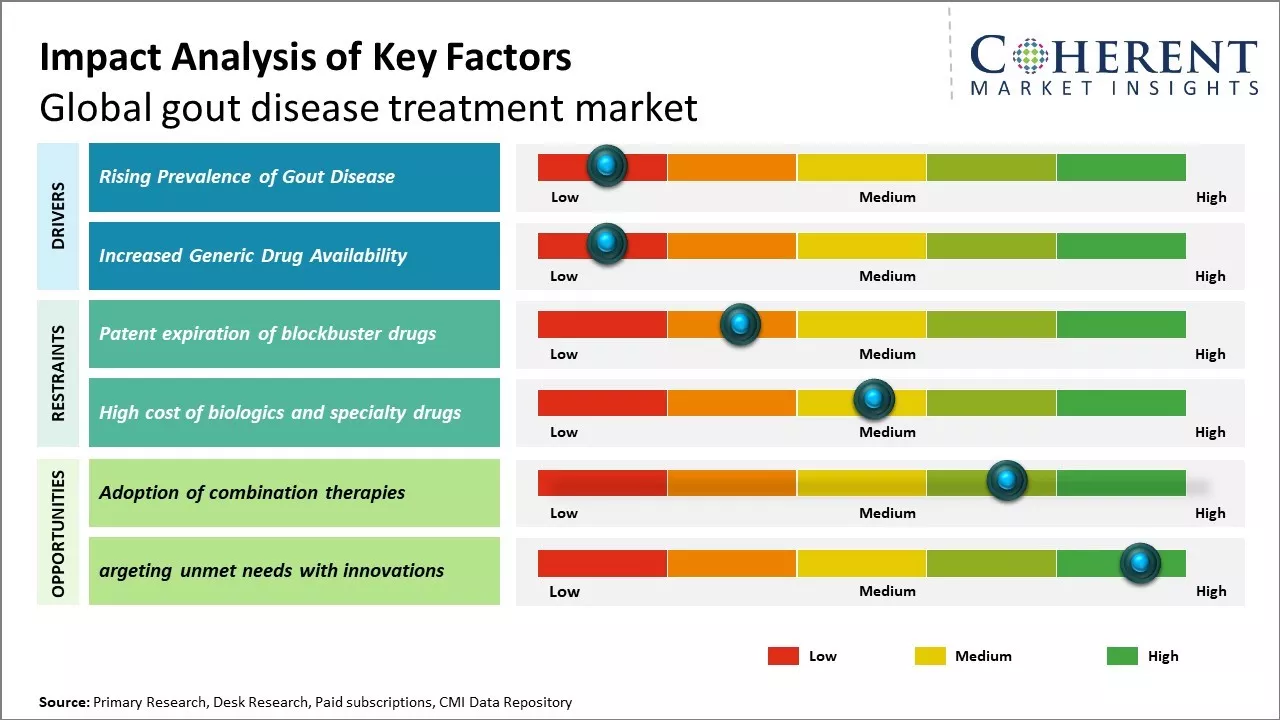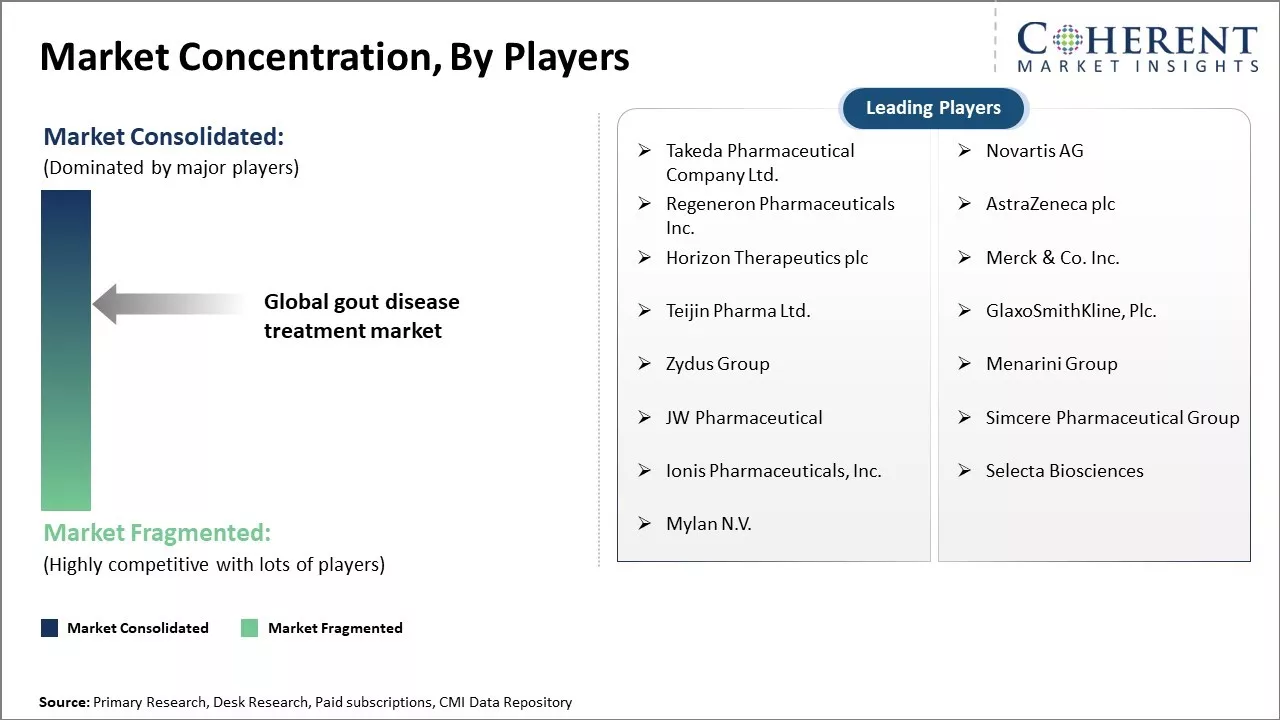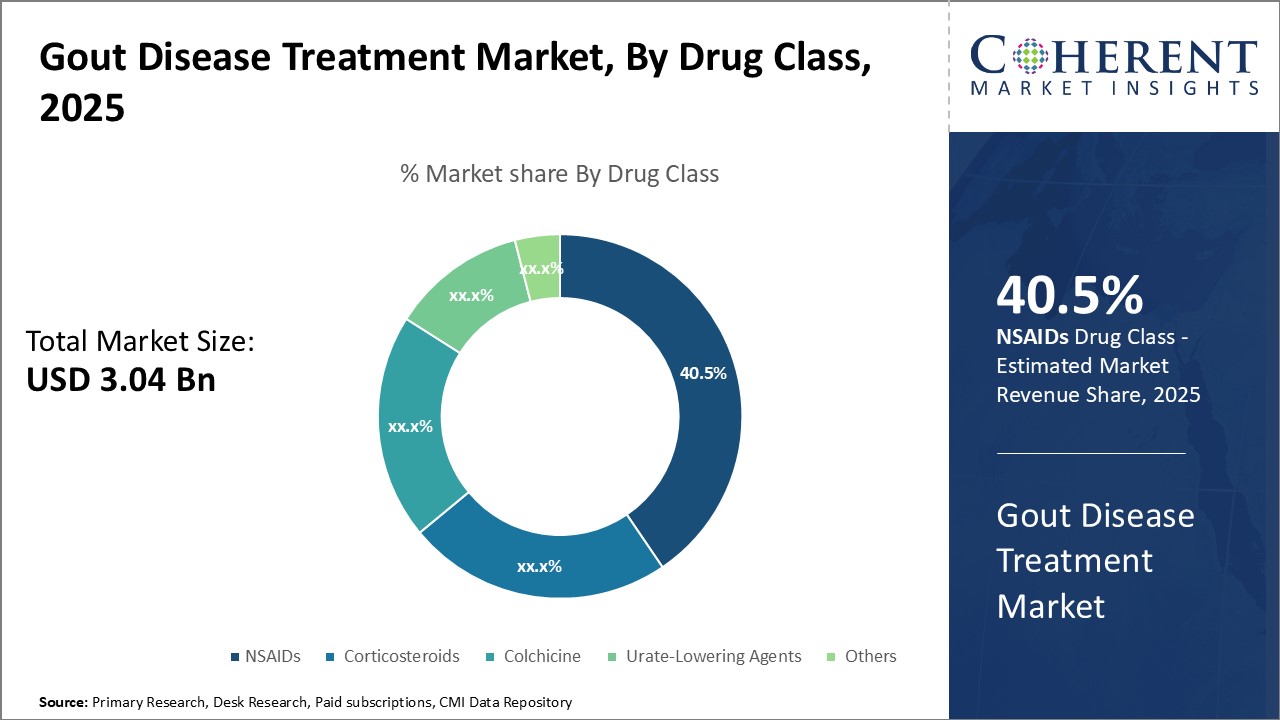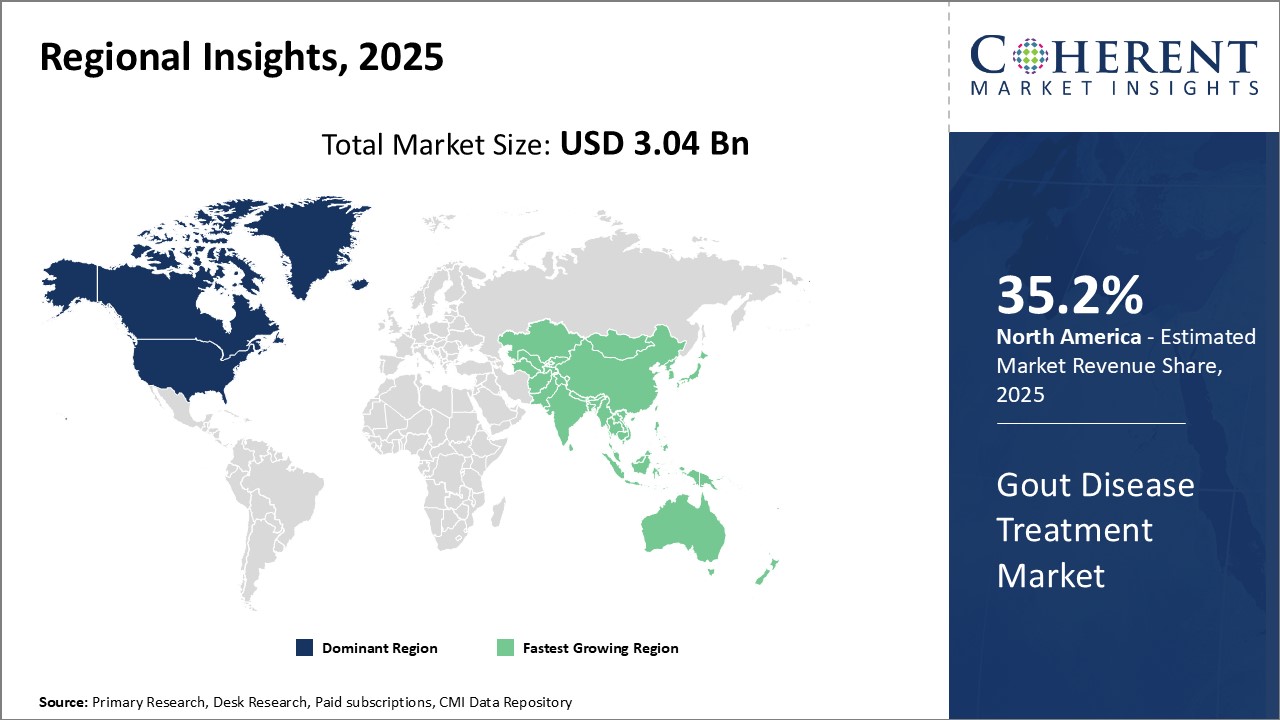Global gout disease treatment market is estimated to be valued at USD 3.04 Bn in 2025 and is expected to reach USD 5.32 Bn by 2032, exhibiting a compound annual growth rate (CAGR) of 8.3% from 2025 to 2032.

Discover market dynamics shaping the industry: Download Free Sample
The market is expected to witness positive growth over the forecast period due to factors such as growing geriatric population that are more prone to gout disease, increasing awareness about the disease, and availability of various treatment options. However, stringent regulations for new drug development and side effects associated with existing drugs can hamper the market growth. Key market players are focusing on new product innovations and launches to strengthen their market position. For instance, in 2021, Horizon Therapeutics plc received U.S. Food and Drug Administration (FDA) approval for KRYSTEXXA for treatment of chronic gout in adult patients.
Rising Prevalence of Gout Disease
Gout disease is increasingly becoming prevalent across the global population. This chronic inflammatory arthritis condition is being influenced by various lifestyle and dietary factors. The consumption of purine-rich foods like meat, seafood and alcohol is known to elevate uric acid levels in the bloodstream and contribute to the onset of gout attacks. Changing dietary habits, excessive weight gain and physical inactivity have made many individuals prone to developing hyperuricemia and gout. The gout prevalence is particularly higher in developed Western nations where people adopt sedentary urban lifestyles and consume greater amounts of purine-rich animal protein sources. Higher life expectancy globally also contribute to rising gout prevalence.. Genetic predisposition along with age-related decline in kidney function further raises uric acid levels in many older individuals. Their compromised immune systems make them susceptible to frequent gout flares. The disease burden has been escalating not nly in developed regions but also in emerging nations undergoing rapid economic development and lifestyle transition. Greater awareness along with improved diagnosis has additionally contributed to higher gout patient rates worldwide in recent times. For instance, in June 2021, according to a article published by Annals of Rheumatic Diseases titled 'Has the gout epidemic peaked in the UK?,' the prevalence of gout had increased from 0.98% in 1997 to 2.33% in 2021. The incidence of gout had also increased by 0.98 per 1,000 persons in 2021. This significant burden of gout can boost demand for medications treating this condition, thus, driving the market growth.

Get actionable strategies to beat competition: Download Free Sample
Increased Generic Drug Availability
The expiry of patents and introduction of generic medicines have provided more treatment choices and lowered drug costs for gout patients. Several pivotal gout drugs including allopurinol and colchicine have gone off-patent, allowing many pharmaceutical companies to manufacture and market affordable generic equivalents. This has expanded treatment access in both developed and developing healthcare markets. Particularly in developing Asian and Latin American countries, cheaper generics have helped to address the growing needs of their population burdened by gout. The good cost-benefit ratio and increasing familiarity with generic medicines have prompted many physicians to prescribe lower-cost generic therapy as the first line of treatment. With rising global gout rates due to lifestyle changes, the extensive availability of more affordable generic options has facilitated widespread treatment uptake to better manage this increasingly common form of arthritis. Generic drugs have played a catalytic role in boosting uptake of prescription therapies.
Key Takeaways from Analyst:
Global gout disease treatment market growth is driven by rising geriatric population globally who are more prone to gout. Furthermore, changing lifestyle and dietary habits leading to increased consumption of purine-rich foods and drinks like meat especially red meat, seafood and alcohol can further contribute to prevalence of gout. However, availability of alternative treatment options like lifestyle changes and home remedies for patients with mild gout symptoms can hamper the market growth. The penetration of generic drugs once blockbuster patents expire can challenge the growth prospects of leading brands. Asia Pacific region especially China and India will witness fastest growth in the forecast period, owing to rising healthcare expenditure, growing medical tourism and massive patient pool. Within Asia, Japan already has one of the highest gout prevalence. Among the various drug classes, xanthine oxidase inhibitors are likely to retain their top position led by allopurinol due to their efficacy and wide acceptance as the first line treatment option. However, uric acid absorption inhibitors are poised to gain significant market share due to their recently introduced alternatives like febuxostat with better tolerability.
Market Challenges: Patent Expiration of Blockbuster Drugs
The patent expiration of several blockbuster drugs in recent years can hamper the global gout disease treatment market growth. When profitable drugs lose their patent protection, generic versions enter the market at much lower prices, capturing a major share of sales from the original brand. This drastically reduces revenue for companies that held the initial patents. For example, the patent expiration of allopurinol, one of the most commonly prescribed medications for chronic gout, in the late 2010s had a noticeable impact. Allopurinol, also known by its brand name Zyloprim, lost exclusivity in the U.S. in 2016 and in Europe in 2018. Several generic drugmakers were then able to mass produce allopurinol at a fraction of the original cost. As a result, sales of the branded Zyloprim declined sharply as patients and physicians opted for the cheaper generics instead. The patent loss of allopurinol removed a key profit driver for its innovator company and curtailed opportunities for growth in that drug segment. Patent expirations of major biologic drugs for gout such as Krystexxa (pegloticase) and IIumina (canakinumab), which occurred in 2021 and 2022 respectively also hampered the market growth. Biologics represented an area that previously showed high potential for the gout therapy market. However, with the ability of biosimilars to capture up to 80% of the market within a year or two after losing exclusivity, the biosimilar competition will seriously limit the gains that innovators anticipated from these biologic drugs.
Market Opportunities: Adoption of Combination Therapies
The treatment of gout has traditionally relied on monotherapies to manage inflammation and reduce uric acid levels. However, gout is a complex disease with multiple pathogenic factors, and patients often struggle to maintain target uric acid levels and experience flare ups long term with single drugs. Combination therapies employing two or more drugs with complementary mechanisms of action have shown promise in improving outcomes for patients. Combining a urate-lowering therapy with an anti-inflammatory provides a dual approach to both reduce uric acid build up and control flare ups more effectively. In 2021, according to the study published by Arthritis & Rheumatology Journal, combining allopurinol with febuxostat led to a higher percentage of patients achieving target uric acid levels compared to either drug alone, reducing flares and improving quality of life. Combining anti-inflammatories like colchicine or NSAIDs with a urate-lowering drug has also significantly decrease the risk of flares in patients starting urate-lowering treatment, according to a 2020 report from the Centers for Disease Control. As physicians and patients realize the advantages of combination strategies, there will be huge adoption. . This presents a major opportunity for pharmaceutical companies to develop innovative fixed-dose combination products that improve outcomes and adherence for gout patients.

Discover high revenue pocket segments and roadmap to it: Download Free Sample
By Drug Class- Rising prevalence of acute gout boosts demand for NSAIDs
In terms of drug class, NSAIDs segment is estimated to contribute the highest market share of 40.5% in 2025, owing to rising prevalence of acute gout attacks globally. As NSAIDs are primarily used for treating flare-ups or acute attacks of gout, their demand is directly linked to the number of gout patients experiencing acute episodes. The incidence of acute gout has been increasing worldwide due to growing elderly population, rising obesity levels, increasing consumption of alcohol and purine-rich foods. As these risk factors continue to rise, more patients are prone to acute gout attacks that cause sudden and severe joint pain. NSAIDs are widely used as the first line of treatment and provide effective relief from inflammation and pain associated with acute gout. Their over-the-counter availability and easy dose administration boost patient preference for NSAIDs during gout flares.
By Disease Type- Chronic gout management boosts demand for urate-lowering agents
In terms of disease type, chronic gout segment is estimated to contribute the highest market share of 60.5% in 2025, owing to expanding patient base seeking long-term hyperuricemia management. Urate-Lowering Agents, which lower uric acid levels in the bloodstream, are used by chronic gout patients to prevent recurrent attacks. Chronic gout requires lifelong pharmacological intervention beyond acute attack treatment to control uric acid levels and avoid future episodes. The rising diagnosis of chronic gout, triggered by rising risk factors like obesity, increased consumption of purine-rich diets, and increased alcohol intake, boosts demand for urate-lowering Agents. Diet and lifestyle changes alone often fail to maintain uric acid levels in chronic patients, prompting higher reliance on urate-lowering agents to achieve and sustain target uric acid goals long-term.
By Distribution Channel- Hospital pharmacies lead due to the acute nature of gout
In terms of distribution channel, hospital pharmacies segment is estimated to contribute the highest market share of 40.5% in 2025, due to the predominantly acute nature of gout attacks. Most gout patients consult doctors and receive medication during acute attacks as joint pain spikes suddenly and requires prompt attention. Since doctors prefer administering initial gout treatment from hospitals where patients can be examined thoroughly and advised accurately on condition management, hospital pharmacies dispense significant quantities of anti-gout drugs, especially NSAIDs for acute gout flares. Even for recurring gout attacks or chronic management, some patients opt for hospital follow-ups and procure medicines from hospital pharmacies located nearby. This makes hospital pharmacies a key access point and an efficient distribution network for gout treatment drugs.

Need a Different Region or Segment? Download Free Sample
North America dominates the global gout disease treatment market with an estimated market share of 35.2% in 2025. The U.S. has a large patient population suffering from gout, estimated to be over 8 million people. This is primarily due to lifestyle factors such as high consumption of meat and seafood, along with drinks like beer which are known risk factors for gout.
The region also has a strong presence of leading pharmaceutical manufacturers focused on developing novel therapies for gout. Companies like Takeda, Horizon Therapeutics and Ironwood regularly invest in clinical research to advance treatment options beyond conventionally used drugs. Well-established healthcare and medical reimbursement systems ensure high affordability and access to prescribed medications. Thus, the region is quick to adopt new drugs which receive regulatory approvals.
Asia Pacific has emerged as the fastest growing gout disease treatment market globally. Countries like China and India account for the bulk of the regional growth due to expanding medical needs of their massive populations. While gout was traditionally more prevalent in Western nations, lifestyle changes across Asia are contributing to rising incidence rates of gout. Growing personal income levels simultaneously increase individuals' ability to afford prescribed medications without dependence on subsidized public systems as well.
Gout Disease Treatment Market Report Coverage
| Report Coverage | Details | ||
|---|---|---|---|
| Base Year: | 2024 | Market Size in 2025: | USD 3.04 Bn |
| Historical Data for: | 2020 To 2024 | Forecast Period: | 2025 To 2032 |
| Forecast Period 2025 to 2032 CAGR: | 8.3% | 2032 Value Projection: | USD 5.32 Bn |
| Geographies covered: |
|
||
| Segments covered: |
|
||
| Companies covered: |
Takeda Pharmaceutical Company Ltd., Novartis AG, Regeneron Pharmaceuticals Inc., AstraZeneca plc, Horizon Therapeutics plc, Merck & Co. Inc., Teijin Pharma Ltd., GlaxoSmithKline, Plc., Zydus Group, Menarini Group, JW Pharmaceutical ,Simcere Pharmaceutical Group, Ionis Pharmaceuticals, Inc., Selecta Biosciences, Mylan N.V. |
||
| Growth Drivers: |
|
||
| Restraints & Challenges: |
|
||
Uncover macros and micros vetted on 75+ parameters: Get instant access to report
*Definition: Global gout disease treatment market consists of pharmaceutical treatments that manage the symptoms and reduce occurrences of gout disease. This market includes drugs like allopurinol, febuxostat, pegloticase, and colchicine that lower uric acid levels and reduce inflammation caused by excess uric acid accumulation in joints. The treatment options aim to control the levels of uric acid in the bloodstream and body to prevent gout attacks and remove urate crystals that have formed inside and around the joints.
Share
Share
About Author
Ghanshyam Shrivastava - With over 20 years of experience in the management consulting and research, Ghanshyam Shrivastava serves as a Principal Consultant, bringing extensive expertise in biologics and biosimilars. His primary expertise lies in areas such as market entry and expansion strategy, competitive intelligence, and strategic transformation across diversified portfolio of various drugs used for different therapeutic category and APIs. He excels at identifying key challenges faced by clients and providing robust solutions to enhance their strategic decision-making capabilities. His comprehensive understanding of the market ensures valuable contributions to research reports and business decisions.
Ghanshyam is a sought-after speaker at industry conferences and contributes to various publications on pharma industry.
Missing comfort of reading report in your local language? Find your preferred language :
Transform your Strategy with Exclusive Trending Reports :
Frequently Asked Questions
Joining thousands of companies around the world committed to making the Excellent Business Solutions.
View All Our Clients